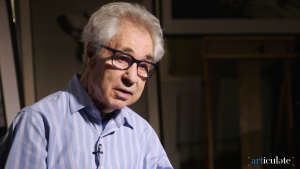Elliott Erwitt’s Moments in Time
Description
For more than seven decades, the photographer Elliott Erwitt has been lauded for his humor and visual wit.
Featured Artists

Elliott Erwitt is a masterful documentary photographer, known for his visual wit, impeccable timing, and quiet observation.
He was born in Paris to Russian Jewish parents and lived in Italy before emigrating to the United States on the eve of World War II. He entered the U.S. military in 1950 and won a prize from LIFE magazine for photographs he took while stationed in Europe. After his service, he moved to New York and joined the iconic Magnum photo collective, working for decades as a freelance photographer in journalism and advertising.
His subjects range from mundane to the epochal. He captured iconic photos of everyday life—dogs on the streets of New York, segregated water fountains in the South—and took famous images of key 20th-century events: Jackie Kennedy crying at JFk’s funeral and the “kitchen debate” between Richard Nixon and Soviet Premier Nikita Kruschev. His works are held in the collections of the Art Institute of Chicago, the National Gallery of Art in Washington, D.C., and the Cleveland Museum of Art, among others.
Transcript
Elliott Erwitt is one of the finest photographers of the 20th century. He’s captured the glamor of Marilyn Monroe, the anguish of Jackie Kennedy, and the utter absurdity of everyday life. But though he’s celebrated for his visual wit and impeccable timing, Erwitt doesn’t think of himself as particularly amusing.
Elliot Erwitt: My sense of humor is really a judgment that other people can make. I don’t know if I’m funny, but I’d rather be funny than tragic.
Erwitt’s life very well could have been tragic. He was born Elliot Erwitz in 1928 Paris to Russian-Jewish immigrants who would ultimately flee Europe for New York in the late summer of 1939.
Erwitt: I came to this country at the age of 11. On the last boat leaving from France as the war was declared on September 3rd. It’s been fairly exciting since then.
To describe his life as only fairly exciting is an understatement. Erwitt has photographed nearly every pope since Pius XII, and every US president from Harry Truman to Barack Obama. Erwitt first became obsessed with photography as a teenager. After his parents divorced, he moved to Hollywood with his father, where he got an afterschool job at a photo lab printing autographed pictures of movie stars. Less than a year later, his dad moved again to New Orleans, leaving the young Elliott to take over his father’s house, and learn to fend for himself.
Erwitt: I would say that I, since the age of 16 and a half I’ve been on my own.
AJC: Was there any sense of panic that you had to be a fully-fledged adult at that juncture?
Erwitt: I was whatever I was not by choice but by necessity, I think, at that age. I didn’t have a chance to make choices until later on in life.
AJC: Were you scared when you got drafted?
Erwitt: I mean, I was quite lucky it was during the Korean War, and I went to Europe and had a great time. I did take a lot of pictures because I always carried a Leica camera in my fatigues, and there was plenty of time to do that because being in the army in Europe at that time was a pretty easy gig.
AJC: Did you ever get in trouble for having your camera out and not focusing on army things?
Erwitt: On the contrary, I didn’t get in trouble I won a prize in a contest run by Life magazine at the time. I got second prize. And I got a commendation from the officer of my platoon or group, or whatever it was. And I had the unique opportunity with the money that I won to buy a car. And so, while my tour of duty in Europe was going on, I had time and place to take pictures, and the car to get me there.
After he left the army in 1953, Erwitt returned to New York City where he was accepted into the now iconic, then nascent, photography collective Magnum. There, he joined the ranks of those he had admired from afar. Among them, Henri Cartier-Bresson. This was when Erwitt’s now more than 60-year long career really took flight. Through it all, this extraordinary artist has maintained the enthusiasm of the amateur, and always trusted luck to put him in the right place at the right time.

